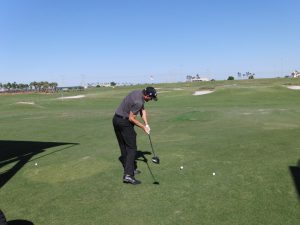Email Lesson

By Dr. T. J. Tomasi, Keiser University College of Golf Senior Faculty and Director of Research
Brian, one of the tour players I work with, is a very long hitter with a Trackman measured swing speed of 126 mph – he hits his tee ball well over 300 yards. We worked on his swing for about two years, and then it was time for him to compete. He has traveled the world well, but it isn’t easy to play your best golf in a different country every week.
What gives tour players fits is not the motor memory of the swing (the What); it’s the When; the spot-on timing that arranges the What in a powerful sequence that keeps repeating. Below are photos addressing the problem that crept into his swing on the road. The danger is that issues with the When often cause unnecessary tinkering that can ruin a swing.
Brian reported he was not compressing the ball and wanted to know if he should make a change in his shoulder action. Here is my email to him after he sent his swing video.
“No, it’s not the tilt of your shoulders – don’t mess with that – your shoulders are perfect in that they angle at the ground to allow you to swing upright, which is critical – if you swing more horizontal (flatter), it would trap the club behind you as when we first met causing big hooks and pushes as a result.
Have you been doing flex exercises? They shore up the critical move where your upper body turns while the lower body stays quiet. This allows your weight to shift naturally, and it’s only near the top that the spine tilts a bit toward the target and down as a natural response to coil. If you are not doing stretching, you should resume. And it’s not keeping your head still either – the concept is to stay tall until the top. It may be as simple as just thinking about keeping the spine angle/pelvis angle (about 20 degrees) until you arrive at the top where the angle decreases slightly, then it drops again in a power dive back to 20, then to 0 at impact.
Your drop is beautiful, but it must unfold correctly; too much drop too early means a mis-sequence. Work on staying tall, i.e., keeping posture, then the downswing unfolds.
Drill – Place a regular drinking straw in your mouth – or something you can see while you swing to monitor your motion. Don’t let the straw drop down during the backswing. Hit a bunch of easy shots keeping the straw level, then film with straw and send it to me.”
If you’d like to study with Dr. Tomasi and other PGA Master Professionals, contact The College of Golf today.

This is a photo sequence of his correct spine movement. Since his shoulder turn is incomplete, he has not dropped his spine down yet. The drop is part of the power move during the downswing, and the straw drill lets him see what was happening spine-wise.

Note the increase in spine angle with the ground– it occurred on the downswing, which is good – not on the backswing, which is not good.














